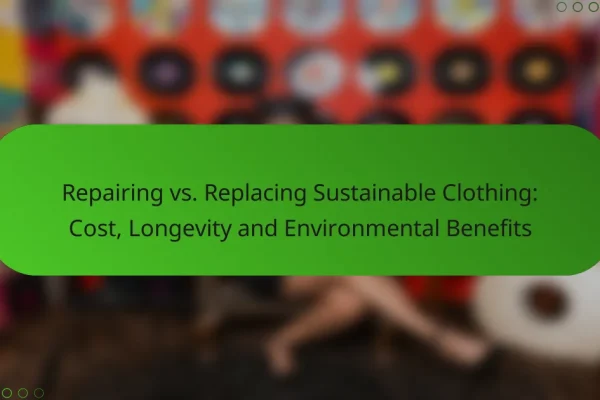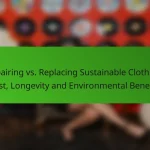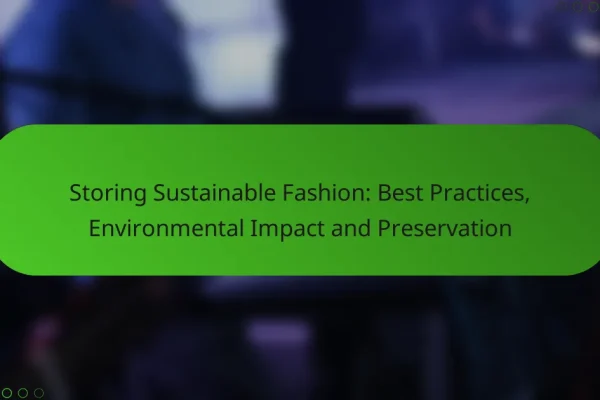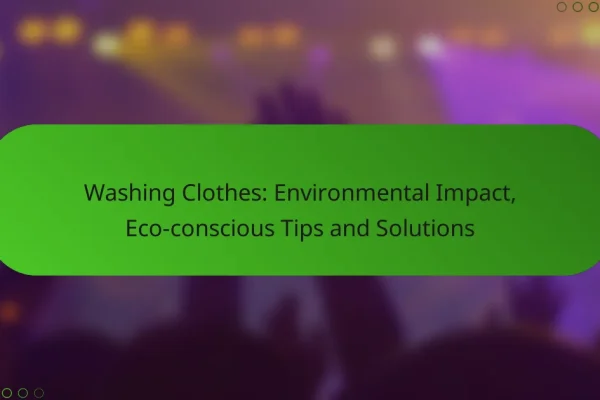How to care for sustainable fashion in urban environments
Caring for sustainable fashion in urban environments involves using eco-friendly practices that extend the life of your garments while minimizing environmental impact. Simple actions like choosing the right detergents and drying methods can make a significant difference.
Use eco-friendly detergents
Opt for detergents that are biodegradable and free from harsh chemicals. Look for labels that indicate they are safe for the environment, as these products help reduce water pollution and are gentler on fabrics.
Consider using concentrated formulas, which require less packaging and reduce transportation emissions. Brands that offer refillable options can further enhance sustainability by minimizing plastic waste.
Follow proper washing instructions
Always check the care label on your garments for specific washing instructions. Following these guidelines helps maintain the fabric’s integrity and color, ensuring your clothing lasts longer.
Generally, washing clothes in cold water and on a gentle cycle can prevent wear and tear. Avoid overloading the washing machine to allow for proper cleaning and reduce strain on fabrics.
Air dry instead of tumble drying
Air drying is a more sustainable option compared to tumble drying, as it saves energy and reduces wear on garments. Hang clothes on a line or a drying rack in a well-ventilated area to help them dry naturally.
If you must use a dryer, select a low heat setting and remove clothes while slightly damp to minimize damage. This approach can extend the life of your clothing significantly.
Store garments properly
Proper storage is crucial for maintaining the quality of sustainable fashion. Store garments in a cool, dry place away from direct sunlight to prevent fading and deterioration.
Use breathable garment bags for delicate items and avoid overcrowding your closet, which can lead to wrinkles and fabric damage. Consider using cedar blocks or lavender sachets to deter moths naturally.
Repair instead of replacing
When clothing gets damaged, consider repairing it instead of discarding it. Simple fixes like sewing buttons or patching holes can extend the life of your garments and reduce waste.
Many urban areas offer workshops or online resources for learning basic sewing skills. Embracing a repair mindset not only saves money but also promotes a more sustainable approach to fashion consumption.
What are the best practices for maintaining eco-friendly fabrics?
To maintain eco-friendly fabrics, prioritize gentle care methods that preserve the material’s integrity and reduce environmental impact. Regular maintenance, such as proper washing and storage, can significantly extend the lifespan of these sustainable textiles.
Understand fabric types
Different eco-friendly fabrics, such as organic cotton, linen, and Tencel, have unique care requirements. Familiarizing yourself with these materials helps in choosing the right cleaning methods and products. For instance, organic cotton is generally durable but may shrink if washed in hot water, while Tencel is more sensitive and benefits from gentle handling.
Check labels for specific care instructions, as they often provide valuable insights into the best practices for each fabric type. Understanding these nuances can prevent damage and maintain the fabric’s eco-friendly properties.
Use gentle cleaning methods
When cleaning eco-friendly fabrics, opt for cold or lukewarm water and a gentle cycle to minimize wear and tear. Hand washing is often the best choice for delicate materials, as it reduces agitation and potential damage. If machine washing, use a mesh bag to protect the fabric from snagging.
Drying should also be approached with care; air drying is preferable to machine drying, which can lead to shrinkage and fading. If using a dryer, select a low heat setting to avoid harming the fabric.
Avoid harsh chemicals
Harsh detergents and fabric softeners can degrade eco-friendly fabrics and harm the environment. Instead, choose biodegradable detergents that are free from synthetic fragrances and dyes. Look for products labeled as eco-friendly or plant-based to ensure they are safe for both your clothing and the planet.
Additionally, consider using natural alternatives like vinegar or baking soda for deodorizing and softening fabrics. These options are effective and less harmful than conventional chemical cleaners.
How can consumers extend the lifespan of their clothing?
Consumers can extend the lifespan of their clothing by adopting simple care practices and making mindful purchasing decisions. Regular maintenance, investing in quality garments, and engaging in clothing swaps are effective strategies to promote sustainability in fashion.
Implement regular maintenance routines
Establishing a regular maintenance routine is essential for prolonging the life of clothing. This includes washing garments at lower temperatures, air drying instead of using a dryer, and promptly repairing any damages like loose buttons or small tears.
Consider creating a checklist for garment care, such as checking care labels for specific instructions, using gentle detergents, and storing clothes properly to prevent damage. Regularly inspecting your wardrobe can help you catch issues early and keep your clothes looking their best.
Invest in quality over quantity
Choosing quality clothing over quantity is a key factor in extending garment lifespan. High-quality fabrics and craftsmanship often result in more durable pieces that withstand wear and tear better than cheaper alternatives.
When shopping, look for items made from natural fibers like cotton, wool, or linen, as they tend to be more durable. Additionally, consider brands that prioritize sustainable practices and ethical production, as they often produce longer-lasting clothing.
Participate in clothing swaps
Clothing swaps are a practical way to refresh your wardrobe while promoting sustainability. By exchanging items with friends or participating in community events, you can acquire new pieces without contributing to fast fashion waste.
Organize a clothing swap by inviting friends to bring items they no longer wear. Set up a simple system where everyone can browse and choose pieces they like. This not only extends the life of clothing but also fosters a sense of community and shared responsibility for sustainable fashion.
What are the environmental impacts of clothing care?
The environmental impacts of clothing care primarily stem from water usage, energy consumption, and pollution. Each of these factors contributes to the overall ecological footprint of maintaining garments, making it essential to adopt more sustainable practices.
Water consumption during washing
Washing clothes consumes significant amounts of water, often ranging from 50 to 100 liters per load, depending on the machine and settings used. This high water usage can strain local water resources, especially in areas facing drought or water scarcity.
To minimize water consumption, consider washing full loads instead of smaller ones and using eco-friendly washing machines that are designed to use less water. Additionally, opting for cold water cycles can reduce both water and energy usage.
Energy usage in drying
Drying clothes, particularly in electric dryers, can consume a considerable amount of energy, often accounting for a significant portion of a household’s energy bill. The energy required for drying can vary widely, but it typically ranges from 2 to 5 kWh per load.
To reduce energy usage, consider air-drying clothes whenever possible. If using a dryer, select energy-efficient models and avoid overloading to ensure efficient drying. Using dryer balls can also help reduce drying time.
Microfiber pollution from washing
Washing synthetic fabrics releases microfibers into the water system, contributing to plastic pollution in oceans and waterways. Studies suggest that a single wash can release thousands of microfibers, which can harm marine life and enter the food chain.
To combat microfiber pollution, consider using a microfiber-catching bag or filter during washes. Additionally, reducing the frequency of washing and choosing natural fibers can help minimize the release of microplastics into the environment.
How to choose sustainable fashion brands?
Choosing sustainable fashion brands involves evaluating their environmental impact, ethical practices, and transparency. Look for brands that prioritize eco-friendly materials, fair labor conditions, and clear supply chain information.
Evaluate materials used
When assessing sustainable fashion brands, consider the materials they use. Look for organic cotton, Tencel, hemp, or recycled fabrics, which have a lower environmental footprint compared to conventional materials. Brands that disclose their sourcing practices often demonstrate a commitment to sustainability.
Check for ethical labor practices
Ethical labor practices are crucial in sustainable fashion. Research whether brands adhere to fair wage policies and safe working conditions. Certifications like Fair Trade or membership in the Ethical Trading Initiative can indicate a brand’s commitment to ethical labor standards.
Look for transparency in supply chains
Transparency in supply chains is essential for identifying truly sustainable brands. Brands that openly share information about their production processes, sourcing, and labor practices allow consumers to make informed choices. Seek out brands that provide details on their website or through third-party audits.
Consider the brand’s overall impact
Assess the overall impact of a brand by examining its environmental initiatives and community engagement. Brands that invest in sustainable practices, such as reducing waste or supporting local artisans, often have a more positive influence. Look for companies that actively promote circular fashion, such as recycling programs or take-back schemes.










